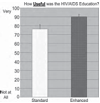Computer-assisted HIV prevention for youth with substance use disorders
- PMID: 21190405
- PMCID: PMC3091163
- DOI: 10.3109/10826084.2011.521088
Computer-assisted HIV prevention for youth with substance use disorders
Abstract
We developed an interactive, customizable, Web-based program focused on the prevention of HIV, sexually transmitted infections, and hepatitis among youth. Results from a randomized, controlled trial with youth in treatment for substance use demonstrated that this Web-based tool, when provided as an adjunct to an educator-delivered prevention intervention, increased accurate prevention knowledge, increased intentions to carefully choose partners, and was perceived as significantly more useful relative to the educator-delivered intervention when provided alone. Results suggest this Web-based program may be effective and engaging and may increase the adoption of effective HIV and disease prevention science for youth. Limitations are discussed.
Conflict of interest statement
In addition to their affiliations listed above, the first three authors are affiliated with HealthSim, LLC, the health-promotion software development organization that developed the web-based intervention evaluated in this study. The authors have worked extensively with their institutions to manage any potential conflict of interest. Additionally, all statistical analyses were conducted by an independent statistician.
Figures
Similar articles
-
Comparative Effectiveness of Web-Based vs. Educator-Delivered HIV Prevention for Adolescent Substance Users: A Randomized, Controlled Trial.J Subst Abuse Treat. 2015 Dec;59:30-7. doi: 10.1016/j.jsat.2015.07.003. Epub 2015 Jul 15. J Subst Abuse Treat. 2015. PMID: 26293644 Free PMC article. Clinical Trial.
-
Sexually transmitted diseases, human immunodeficiency virus, and pregnancy prevention. Combined contraceptive practices among urban African-American early adolescents.Arch Pediatr Adolesc Med. 1996 Jan;150(1):17-24. doi: 10.1001/archpedi.1996.02170260021003. Arch Pediatr Adolesc Med. 1996. PMID: 8542001 Clinical Trial.
-
Condom use relative to knowledge of sexually transmitted disease prevention, method of birth control, and past or present infection.J Community Health. 1994 Dec;19(6):395-407. doi: 10.1007/BF02260322. J Community Health. 1994. PMID: 7844245
-
Application of interactive, computer technology to adolescent substance abuse prevention and treatment.Adolesc Med State Art Rev. 2007 Aug;18(2):342-56, xii. Adolesc Med State Art Rev. 2007. PMID: 18605650 Review.
-
Adolescent condom use, the health belief model, and the prevention of sexually transmitted disease.J Obstet Gynecol Neonatal Nurs. 1996 Jan;25(1):61-6. doi: 10.1111/j.1552-6909.1996.tb02514.x. J Obstet Gynecol Neonatal Nurs. 1996. PMID: 8627404 Review.
Cited by
-
Leveraging technology to enhance addiction treatment and recovery.J Addict Dis. 2012;31(3):313-8. doi: 10.1080/10550887.2012.694606. J Addict Dis. 2012. PMID: 22873192 Free PMC article. Review.
-
Advances in the psychosocial treatment of addiction: the role of technology in the delivery of evidence-based psychosocial treatment.Psychiatr Clin North Am. 2012 Jun;35(2):481-93. doi: 10.1016/j.psc.2012.03.009. Epub 2012 Apr 11. Psychiatr Clin North Am. 2012. PMID: 22640767 Free PMC article. Review.
-
Sex Education in the Spotlight: What Is Working? Systematic Review.Int J Environ Res Public Health. 2021 Mar 4;18(5):2555. doi: 10.3390/ijerph18052555. Int J Environ Res Public Health. 2021. PMID: 33806507 Free PMC article.
-
Computerized counseling reduces HIV-1 viral load and sexual transmission risk: findings from a randomized controlled trial.J Acquir Immune Defic Syndr. 2014 Apr 15;65(5):611-20. doi: 10.1097/QAI.0000000000000100. J Acquir Immune Defic Syndr. 2014. PMID: 24384803 Free PMC article. Clinical Trial.
-
Uptake of and Engagement With an Online Sexual Health Intervention (HOPE eIntervention) Among African American Young Adults: Mixed Methods Study.J Med Internet Res. 2021 Jul 16;23(7):e22203. doi: 10.2196/22203. J Med Internet Res. 2021. PMID: 34269689 Free PMC article.
References
-
- Andrew G, Patel V, Ramakrishna J. What to integrate in adolescent health services. Reproductive Health Matters. 2003;11:120–129. - PubMed
-
- Auerbach JD, Kandathil SM. Overview of effective and promising interventions to prevent HIV infection. World Health Organization Technical Report Series. 2006;938:43–78. - PubMed
-
- Benton T, Ifeagwu J. HIV in adolescents: What we know and need to know. Current Psychiatry Reports. 2008;10:109–115. - PubMed
-
- Bickel WK, Marsch LA. A future for drug abuse prevention and treatment in the 21st century: Applications of computer-based information technologies. In: Henningfield J, Santora PB, Bickel WK, editors. Addiction treatment: Science and policy for the 21st century. Baltimore, MD: Johns Hopkins Press; 2007. pp. 35–43.
Publication types
MeSH terms
Grants and funding
LinkOut - more resources
Full Text Sources
Medical


